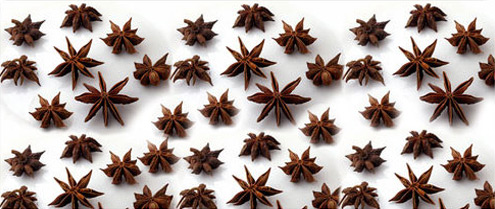OUR TOP TRENDING APPS
Spices are defined as " a strongly flavored or aromatic substance of vegetable origin, obtained from tropical plants, commonly used as a condiment ". In ancient times, spices were as precious as gold; and as significant as medicines , preservatives and perfumes. India - the land of spices, plays a significant role in the global spices market.
Over twelve varieties of spices, including ginger, garlic, cardamom, vanilla, pepper, cinnamon, coffee, tea, clove and nutmeg are cultivated in Kerala
Scientific Name : Piper Nigrum - Temperature : Tolerance -10° C to 40° C. Optimum -20°C to 30°C. Rainfall required : 2500 mm. Propagation : Stem cutting. Important varieties : Panniyur -1, Karimunda, Kuthiravally, Arakkulam Munda, Balankotta and Kalluvally The pepper plant grows best in a warm and humid climate. Berries mature and are ready for harvest in about 180 to 200 days. Black pepper is produced by sun drying the mature pepper berries for 3 - 5 days after they are separated from the spikes by threshing and white pepper by retting mature berries in clean water for 5 - 7 days, removing the outer skin and drying the seed after thorough washing.

Scientific Name : Vanilla Fragrans - Rainfall Required : 1500 - 3000 mm Propagation : Shoot cutting. Pollination: Artificial. The rostellum of the flower is pushed back with a pointed bamboo splinter and the overhanging anther is pressed against the stigma with the thumb, thus smearing pollen over it. The ideal time for pollination is 0600 to 1300 hrs. A tropical orchid requires a warm climate with frequent rains; Vanilla grows best in uncleared jungle areas where it can get filtered sunlight. A creeper, the plant requires support up to a height of about 135 cm. The plant usually begins to flower by the third year. The bean takes 10 to 12 months to reach full maturity.

Scientific Name: Elletteria Cardamom - Best altitude for cultivation : 1500 m above see level. Temperature : 10 - 25°C. Rainfall required. 1500 mm. Propagation : Seedlings and vegetative propagation. Pollinating agent : The honey bee. Harvest season : October to February.

The clove tree is an evergreen that grows to about 8 to 12 m in height. Its gland-dotted leaves are small, simple and opposite. The trees are usually propagated from seeds that are planted in shaded areas. Flowering begins about the fifth year; a tree may annually yield up to 75 pounds (34 kg) of dried buds. The buds, just before the flowers open, are hand-picked in late summer and again in winter and are then sun-dried. The island of Zanzibar, which is part of Tanzania, is the world's largest producer of cloves. Madagascar and Indonesia are smaller producers. Cloves vary in length from about 1/2 to 3/4 inch (13 to 19 mm). Cloves contain 14 to 20 percent essential oil, the principal component of which is the aromatic oil eugenol (70 - 90%). Cloves are strongly pungent owing to eugenol, which is extracted by distillation to yield oil of cloves. Three essential oils are available from this spice: clove bud oil, clove stem oil and clove leaf oil. Each has different chemical composition and flavour. Clove bud oil, the most expensive and the best quality product, contains eugenol (80 - 90%), eugenol acetate (15%) and beta caryophyllene (5 - 12%).
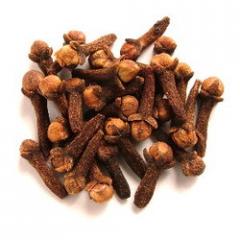
Garlic is one of the most popular spices in the world. The subterranean reserve structure derived from a leaf is the used plant part. It has a strong and characteristic odour, which is markedly different in fresh and fried state. The pungency of fresh garlic vanishes after cooking or frying. The name garlic comes from the Anglo Saxon garleac in which gar, a spear, refers to the pointed leaves and leac is a plant. Other related words include Greek chaîos, a shepherd's crook and maybe Sanskrit hesah, a weapon.The origin of garlic is in Central Asia, but cultivated all over the world, in Spain, France, Egypt, Bulgaria, Hungary, USA, Mexico and Brazil. It features in the mythology, religion and culture of many nations. Arab legend has it that garlic grew from one of the devil's footprints as he left the Garden of Eden. It is reported that in ancient Egypt, the workers who had to build the great pyramids were fed their daily share of garlic, and the Bible mentions garlic as a food the Hebrews enjoyed during their sojourn in Egypt. In Europe, garlic has been a common spice since the days of the Roman Empire, and it was extensively used from India to East Asia even before the Europeans arrived there. In Chinese mythology, garlic has been considered capable of warding off the Evil Eye, the symbol of misfortune and ill fate. After the Age of Exploration, its use spread rapidly to Africa and both Americas.
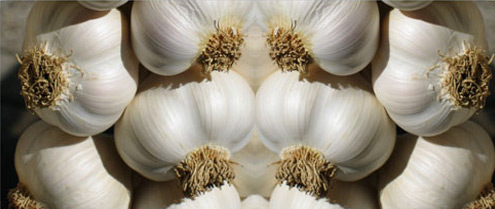
Kerala India Vacations offers online information on ginger, a popular flavoring agent that can be eaten raw and is cooked in various ways to add taste and flavor to dishes. Explore the varieties of ginger plants that are grown in the large Kerala ginger plantations with Kerala India Vacations. The botanical binomial nomenclature for the ginger plant is Zingiber Officianale and it is basically an underground stem. The part of the ginger plant that is visible above ground consists of the stem and leaves.
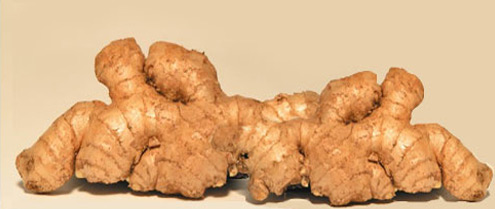
Myristica fragrans or nutmeg is a tropical evergreen tree, which was originally found only in the Indonesian Spice Islands. The colonial rulers introduced the cultivation of nutmeg in India. Kerala India Vacations offers online information on nutmeg and its properties. Visit the Kerala spice plantations with Kerala India Vacations and enjoy scenic vistas and watch nutmeg being harvested in the Kerala spice plantations. The Nutmeg fruit looks quite like an Apricot fruit and the tree can grow up to 20 meters in height. As the nutmeg fruit ripens on the tree the outer crust of the fruit splits naturally to reveal a crimson seed cover with a brown seed within. The seed is gathered as nutmeg and the seed cover is dried as mace that is another popular spice. Used for flavoring bakery products such as cakes, cookies, custards and spice cakes, nutmeg is also used for adding flavor to quite a few culinary preparations. The tropical evergreen nutmeg tree grows very well in a humid and hot tropical climate and thus Kerala, South India is perfect for nutmeg cultivation. Travel to the luxuriant and beautiful Kerala spice plantations and let the aromatic air of these spice plantations transport you into a paradisiacal world. Nutmeg is also known for its medicinal properties and is used for various medicinal concoctions that are utilized for treating diseases.
.
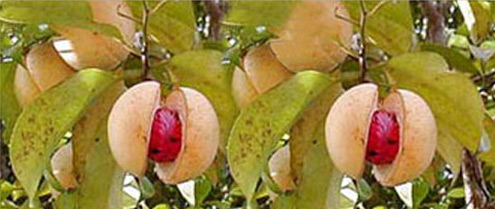
Turmeric (Curcuma longa) is a rhizomatous herbaceous perennial plant of the ginger family, Zingiberaceae. It is native to tropical South Asia and needs temperatures between 20°C and 30°C, and a considerable amount of annual rainfall to thrive. Plants are gathered annually for their rhizomes, and re-seeded from some of those rhizomes in the following season.The rhizomes are boiled for several hours and then dried in hot ovens, after which they are ground into a deep orange-yellow powder commonly used as a spice in curries and other South Asian and Middle Eastern cuisine, for dyeing, and to impart color to mustard condiments. Its active ingredient is curcumin and it has an earthy, bitter, peppery flavor and a mustardy smell.In medieval Europe, turmeric became known as Indian Saffron, since it is widely used as an alternative to the far more expensive saffron spice.
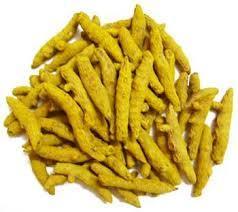
It has evergreen, aromatic leaves and bisexual flowers, the inner petals of which grade gradually into stamens. The flowers are radially symmetrical that lack differentiation between the outer and inner floral whorls (sepals and petals). The female portion of the flower consists of 7 to 15 carpels (ovule-bearing structures), usually in a single whorl. At maturity (after 6 years) the flower produces a characteristic woody fruit composed of a ring of several joined pod like follicles, each of which splits open along one seam to release a single seed. The fruit takes its name from the star like arrangement of its carpels around a central axis. The fruits are harvested before they ripen. The dried fruit is about 0.25 to 0.5 cm (0.1 to 0.2 inch) in diameter; individual carpels are usually about 1 cm in length and contain a single seed. Dried carpels are hard, rough, and reddish brown; the seeds are smooth, lustrous, and light brown in colour. Both the seed and the husk are used for the ground spice. The dried fruit's essential-oil content is about 3 percent, and its principal component is anethole. Star anise is one of the most important spices in Chinese cuisine. It is also used as a flavouring in alcoholic drinks. The dried fruits of star anise are the source of oil of star anise, a volatile, aromatic oil used for flavouring candies, liqueurs, and perfumes. It is used in cough medicines.
